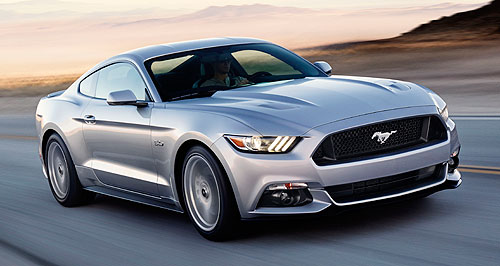Future models - Ford - MustangFour-pot Ford Mustang to rival locally made in-line sixMild horses: Ford’s performance figures for the 2.3-litre turbocharged four-cylinder version of the Mustang reveal it is likely to have more performance than Ford’s Geelong-made in-line six. Ford Mustang to feature six cylinder-rivalling power from turbo-four engine21 Jul 2014 By BARRY PARK A FOUR-CYLINDER version of the Mustang muscle car will pony up more power than the six-cylinder engine that forms part of Ford Australia’s Falcon and Territory line-up. Ford last week released details of its three-engine line-up slated for the sixth-generation of the iconic American muscle car, expected to arrive in Australia late next year and featuring either a turbo four-pot producing about 230kW of power, or a bent eight making about 325kW, under the bonnet. In a twist of irony, the power that the atmo 5.0-litre V8 that the US version of the Mustang produces is down on the 351kW output posted for the final FPV-badged supercharged engine that will retire Ford Australia’s home-grown performance badge late this year. A 225kW V6-engined version of the Mustang – the standard driveline for the range in the United States – is not among Ford Australia’s engine mix. The 2.3-litre EcoBoost direct fuel-injected four-cylinder engine uses a twin-scroll turbocharger and a head with an integrated exhaust manifold that pairs the outer and inner cylinders together to feed into the turbo’s two inlet passages, producing 433Nm of torque and paling the locally made six’s 391Nm. By comparison, the current 2.0-litre turbocharged four-cylinder EcoBoost engine available as an option under the bonnet of the Falcon produces 179kW of power and 353Nm of torque. According to Ford, keeping the exhaust pulses in the Mustang’s four-cylinder engine separated from the next cylinder in the firing order “virtually eliminates mixing losses and maximizes the pulse energy to the turbine wheel”. “The result is similar performance to a more complex twin-turbocharger configuration, meaning quicker turbine spin-up and torque delivery when the driver needs it for passing manoeuvers.” The naturally aspirated V8, meanwhile, will produce about 540Nm of torque, just shy of the supercharged FPV GT F’s 570Nm of torque. “A new intake manifold includes charge motion control valves to partially close off port flow at lower engine speeds,” Ford said. “This increases the air charge tumble and swirl for improved air-fuel mixing, resulting in better fuel economy, improved idle stability and lower emissions.” Buyers will have the choice of either a manual gearbox with the gearshift lever now positioned closer to the driver, or a six-speed automatic transmission with steering wheel-mounted paddle shifters and a throttle blip function to match the engine’s revs on down-shifts. Ford Australia said it was yet to evaluate right-hand drive versions of the Mustang to see how the US version’s performance numbers would translate. Ford is winding down its FPV arm, releasing its last-ever cars to feature the go-fast badge before the locally made range passes into history late this year. The line-up includes the sedan-based GT F featuring a supercharged 351kW 5.0-litre V8, and a 315kW V8-engined Pursuit ute. The Mustang is expected to join Ford Australia’s showrooms late next year as part of a major model overhaul ahead of the car-maker’s withdrawal from Australian manufacturing in late 2016.  Read more6th of December 2013  Mustang might go green, says FordFord pondering diesel, hybrid and even electric versions of MustangAll future models Alfa Romeo Alfa Romeo Abarth Abarth Audi Audi Aston Martin Aston Martin BMW BMW Bentley Bentley Chrysler Chrysler Chevrolet Chevrolet Dodge Dodge Citroen Citroen Ferrari Ferrari DS DS Ford Ford Fiat Fiat FPV FPV Foton Foton Haval Haval Great Wall Great Wall Honda Honda Holden Holden Hyundai Hyundai HSV HSV Isuzu Isuzu Infiniti Infiniti Jeep Jeep Jaguar Jaguar Lamborghini Lamborghini Kia Kia Lexus Lexus Land Rover Land Rover Mazda Mazda Maserati Maserati Mercedes-Benz Mercedes-Benz McLaren McLaren Mini Mini Nissan Nissan Mitsubishi Mitsubishi Peugeot Peugeot Opel Opel Proton Proton Porsche Porsche Renault Renault Ram Ram Saab Saab Rolls-Royce Rolls-Royce Smart Smart Skoda Skoda Subaru Subaru SsangYong SsangYong Tesla Tesla Suzuki Suzuki Toyota Toyota Volvo VolvoMustang pricingMotor industry news |
Click to shareFord modelsAll future models Alfa Romeo Alfa Romeo Abarth Abarth Audi Audi Aston Martin Aston Martin BMW BMW Bentley Bentley Chrysler Chrysler Chevrolet Chevrolet Dodge Dodge Citroen Citroen Ferrari Ferrari DS DS Ford Ford Fiat Fiat FPV FPV Foton Foton Haval Haval Great Wall Great Wall Honda Honda Holden Holden Hyundai Hyundai HSV HSV Isuzu Isuzu Infiniti Infiniti Jeep Jeep Jaguar Jaguar Lamborghini Lamborghini Kia Kia Lexus Lexus Land Rover Land Rover Mazda Mazda Maserati Maserati Mercedes-Benz Mercedes-Benz McLaren McLaren Mini Mini Nissan Nissan Mitsubishi Mitsubishi Peugeot Peugeot Opel Opel Proton Proton Porsche Porsche Renault Renault Ram Ram Saab Saab Rolls-Royce Rolls-Royce Smart Smart Skoda Skoda Subaru Subaru SsangYong SsangYong Tesla Tesla Suzuki Suzuki Toyota Toyota Volvo VolvoMustang pricingMotor industry news |
































Facebook Twitter Instagram